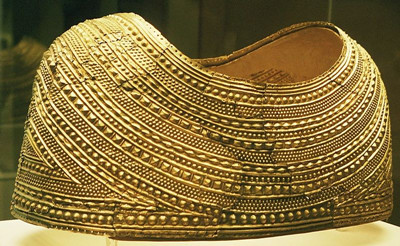It probably had a lining, possibly of leather, which covered the chest and the shoulders of the wearer.
它可能曾有包裹著穿戴者的肩與胸的皮革襯里。
The cape is so fragile, and it would so have restricted the movement of arms and shoulders, that it can only have been very rarely worn.
披肩極為脆弱,同時又極大地限制了肩部與胳膊的活動, 因此應該極少上身。
But there are definite signs of wear, and so it may have been brought out on a number of different ceremonial occasions, perhaps over a long period of time.
但同時上面也有穿戴過的確鑿痕跡:比如,披肩的上緣和下緣皆有孔洞,可能用于將其與服裝相連。綜上所述,它可能只在很長時間舉辦一次的慶典場合穿著。
But 'who' was wearing it?
但到底是什么樣的人在穿?
The cape is too small for a grown man, certainly too small for the mighty warrior of early speculation, and it will fit only a slim small person-a woman or perhaps, more likely, a teenager.
它的尺寸太小,強壯的武士首領應該穿不下,只適合身材痩小的人,如女性或青少年。
Archaeologist Marie-Louise Srensen specialises in the role of the young in these early societies:
考古學家瑪麗路易斯斯蒂索倫森強調了早期社會里年輕人的角色:
"We know that in the early Bronze Age very few people would get older than about 25 years. Most children would not get older than 5.
在青銅時代早期,極少有人能活過二十五歲。大部分兒童在五歲前就夭折了。
Many, many women would die in childbirth, and a few would get very old, and these very old people might have had a very special status in the society.
很多女性難產而死,只有少數人能活到很老。那些年齡較大的人在這樣的社會里可能享有很特別的地位。
"It's actually difficult to know whether our concept of children applies to this society, where you very quickly became a grown-up member of the community, even if you were only 10 years old, because of the average age of the communities that they lived in.
我們其實很難了解現代的兒童觀念是否適用于這樣的社會,由于社會的平均年齡較低,即使只有十歲的人也可能很快被當作成年人對待。
That would mean that most people around them were teenagers, there were very few old people in this kind of society."
當時大部分人口的年齡應該都在十幾歲。
What this of course challenges, is our perceptions of age and responsibility.
這挑戰了我們的年齡和責任概念。












